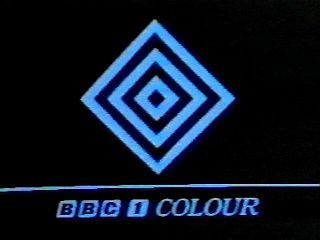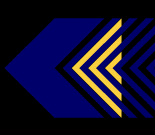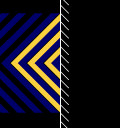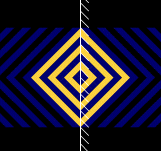This page last updated on Friday, October 13, 2006 at 9:45:57 AM
| Home | | ATV | | ATV Centre | | Schools | | Fenton Relay | | Antenna Theory | | Other Pages |
The Workings of the BBC Schools Diamond
The BBC Schools Diamond was a marvellous mechanical model, so ingenious that it is difficult to imagine how it worked. Dave Jeffery, responsible for the majority of the Flash recontructions on sub-TV, explains how he believes it worked:
"My new Flash Files of the diamond work in the same way as the genuine model; it took a lot of experimenting, and I take my hat off to whoever designed the original model - it was very ingenious and incredibly satisfying to watch. I'm lucky enough to be old enough to have watched the Diamond at the time, and was fascinated by it."

|
|
|
|
The diamond model consists of a static base, with three illuminated chevrons, like this:
|
|
A transparent plastic strip that also has chevrons painted on it is rolled over the static base. Dave created this Flash animation (6kB) to illustrate the point. The chevrons on the transparent plastic strip are coloured blue here so they can be seen - on the model they would have been black. |
|
Once the mirror is in place, the diamond looks like the one we know and love! This Flash animation (11kB) shows what the model looks like with the mirror in place and reflecting. |
Dave asks: "[..]Can anyone confirm or deny that it was designed by BBC Graphic Designer Bernard Lodge?" If you can help, do let me know!
You can see Dave's Flash re-creation of the Diamond on Andrew Wiseman's 625
If you don't have Flash, Dave's original description on how the Diamond worked is below:
The 'BBC 1' lettering is then added underneath the model and shot by a camera. Colours are added electronically afterwards.
"The diamond model is mirrored down the Y axis, with the right side of the diamond being a mirror of the left.
"There is a base that looks like this:
///
\\\
i.e. three illuminated chevrons. These appear light blue (or sandy golden)
on screen, after colour has been added electronically.
"Over this base, there is a transparent plastic roller with black strips painted on that looks like this:
[black]////////////////////////////// \\\\\\\\\\\\\\\\\\\\\\\\\\\\\[black]
[black]\\\\\\\\\\\\\\\\\\\\\\\\\\\\\\ /////////////////////////////[black]
"In other words, it makes up a diamond. This roller moves from left to right.
"The splitting into little diamonds happens when the right hand side of the roller goes over the base underneath. The full diamond sequence runs for two minutes.
"The roller doesn't roll continuously left to right, but starts and stops a lot - must have been a hideously complicated model to make.
"[..]Can anyone confirm or deny that it was designed by BBC Graphic Designer Bernard Lodge?"
You can see Dave's Flash re-creation of the Diamond on Andrew Wiseman's 625




